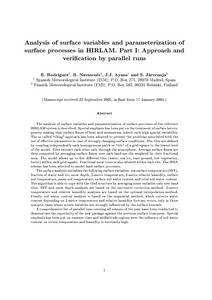Por favor, use este identificador para citar o enlazar este ítem:
http://hdl.handle.net/20.500.11765/12003
Analysis of surface variables and parameterization of surface processes in HIRLAM. Part I: Approach and verification by parallel runs
| Título : | Analysis of surface variables and parameterization of surface processes in HIRLAM. Part I: Approach and verification by parallel runs |
| Autor : | Rodríguez Camino, Ernesto

|
| Palabras clave : | HIRLAM; Surface heterogeneity; Tiles; ISBA scheme |
| Fecha de publicación : | 2009 |
| Editor: | Sveriges meteorologiska och hydrologiska institut |
| Citación : | HIRLAM Technical Report. 2009, 58, p. 1-52 |
| Resumen : | The analysis of surface variables and parameterization of surface processes of the reference HIRLAM system is described. Special emphasis has been put on the treatment of surface heterogeneity making that surface uxes of heat and momentum inherit such high spacial variability. The so called “tiling" approach has been adopted to prevent the problems associated with the use of efective parameters in case of strongly changing surface conditions. The tiles are defined by coupling independently each homogeneous patch or “tile" of a grid square to the lowest level of the model. Tiles interact each other only through the atmosphere. Average surface uxes are then computed by averaging surface uxes over each land-use tile weighted by their fractional area. The model allows up to five diferent tiles (water, sea ice, bare ground, low vegetation, forest) within each grid square. Fractional snow cover is also allowed within each tile. The ISBA scheme has been selected to model land surface processes. The surface analysis initializes the following surface variables: sea surface temperature (SST), fraction of water and ice, snow depth, 2-metre temperature, 2-metre relative humidity, surface soil temperature, mean soil temperature, surface soil water content and total soil water content. The algorithm is able to cope with the tiled structure by averaging some variables only over land tiles. SST and snow depth analyses are based on the successive correction method. 2-metre temperature and relative humidity analyses are based on the optimal interpolation method. Finally, soil water content analysis is based on the sequential method, which corrects water content depending on 2-metre temperature and relative humidity forecast errors, only in those synoptic cases where screen variables are strongly inuenced by the surface beneath. A comprehensive list of parallel runs covering all seasons of the year have been conducted to demonstrate the superiority of the new package against the previous surface treatment. Special emphasis has been put on summer time and midlatitude regions were the inuence of soil wáter content on screen temperature and humidity is extremely high. |
| URI : | http://hdl.handle.net/20.500.11765/12003 |
| Colecciones: | Artículos científicos 2005-2009 |
Ficheros en este ítem:
| Fichero | Descripción | Tamaño | Formato | ||
|---|---|---|---|---|---|
| HIRLAM_TechnicalRepor... | 980,5 kB | Adobe PDF |  Visualizar/Abrir |
Los ítems de Arcimis están protegidos por una Licencia Creative Commons, salvo que se indique lo contrario.





